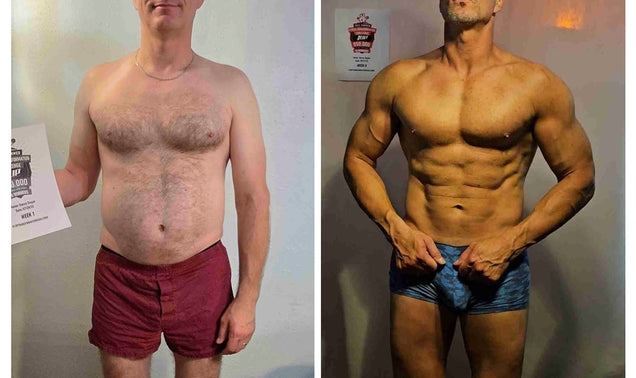When it comes to building muscle or losing fat, proper nutrition is paramount. Don’t get us wrong, training is important, but if you don’t eat to support your performance and physique goals, all of that hard training will be for naught and you won’t achieve the body transformation you so desperately seek.
This means you need to know how many calories you need to eat each day to build muscle or lose body fat.
Two of the biggest acronyms that get thrown around when discussing daily calorie intake are TDEE and BMR.
What do they mean, are they the same thing, and how can they help me to build muscle and lose fat?
In this article, you will find out all of that and more as well as what you need to do to crush your transformation challenge.
TDEE and BMR
Any talk of daily calorie requirements includes both TDEE and BMR.
So, what do these two acronyms actually mean?
TDEE stands for total daily energy expenditure. It is the sum total of all the calories your body burns each day, including those calories burned from exercise. Four main factors govern your TDEE.
TDEE = BMR + TEA + TEF + NEAT
BMR
Basal Metabolic rate (BMR) is but one component (albeit a very BIG component) of your total daily energy expenditure. BMR is the number of calories your body would burn in a day if all you did was lay in bed.
Factors such as age, sex, height, weight, and amount of muscle mass all help determine your basal metabolic rate.
TEA
TEA stands for Thermic Effect of Activity. This is the number of calories you burn during structured physical activity (a.k.a.exercise).
TEA can vary greatly from one person to another or even from day to day depending on the type of workout you do, as well as how long it is and how intense you work out.
TEF
TEF stands for Thermic Effect of Food. This is the number of calories your body expends breaking down the carbohydrates, protein, and fat you eat into sugars, amino acids, and fatty acids that it can use to provide energy, repair muscle tissue, create hormones, and fortify your immune system.
Depending on the makeup of your diet (percentage of carbs, protein, and fat), will determine how large your TEF is. Research notes that TEF can account for up to 10% of TDEE.
More energy is required to digest protein than either carbohydrates or fat, so if you consume a high protein diet, your TEF will be higher than if you consumed a diet lower in protein and higher in carbs and fats.
NEAT
The final component of your TDEE is non-exercise activity thermogenesis (NEAT).
NEAT accounts for the number of calories burned each day from movement not classified as structured exercise. Activities such as walking from one room to another, taking the stairs, blinking, tapping your foot, and fidgeting all count towards your daily NEAT.
Similar to TEA, NEAT is highly variable from one day to another and from one person to another. It can play a significant role in how high or how low your TDEE is. Individuals with more physically demanding jobs will have a much higher NEAT than someone who works behind a desk for 8 hours each day.
How to Use TDEE
Fat loss and muscle gain all come down to energy balance. If you want to lose body fat, you will need to be in a negative energy balance (calorie deficit), and if you want to gain muscle, then you will need to be in a positive energy balance (calorie surplus).
Since most individuals are interested in body recomposition (losing fat and building muscle at the same time), that typically means they have some unwanted body fat that they need to eliminate.
In order to do that, you will need to create a calorie deficit -- calories in is less than calories out.
How to Create a Calorie Deficit
There are two main ways you can enter into caloric deficit in order to lose weight:
- Eat fewer calories (i.e. diet)
- Increase physical activity (i.e. exercise)
Now, the great thing about weight loss is that you don’t have to pick one or the other (diet or exercise). You can do a mixture of BOTH, which is what most successful transformation challenge winners do.
Generally speaking, you want to create a daily calorie deficit of 500 calories. By the end of one week, this will equal a 3500 calorie deficit, which is roughly equal to one pound of body fat.
How can you use a combination of diet and exercise to achieve this daily 500 calorie deficit?
Well, you could start by eliminating 250 calories from your diet (such as one of your daily snacks or meal prep smaller portions). The remaining 250 calories could come from daily weight training and cardio sessions. Remember on your days off from the gym you will not be able to create a caloric deficit with exercise so you need to account for that and create a larger caloric deficit during Monday – Friday with diet and training or create a larger deficit on days off with diet.
The ratio of diet: exercise doesn’t have to be split right down the middle, either.
Just realize that at some point, you can’t keep cutting calories to lose weight, which means you’ll need to exercise more by adding in some weekend cardio or increase cardio sessions.
In the end, the path to a successful body recomp always involves a mixture of proper diet and exercise. By utilizing both, you create significant changes and sustainable habits that you can carry with you for the rest of your life!






